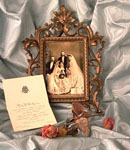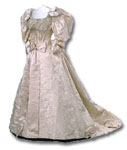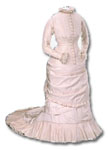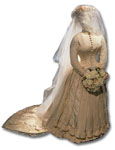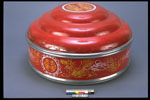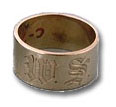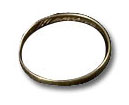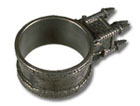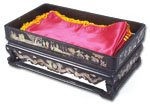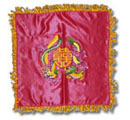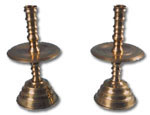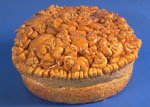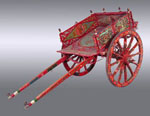|
|
|||||||||||||||||
WeddingsAs social events that bring families and communities together in celebration, weddings are among the most important and universal of all life cycle rituals celebrated in human society. Common elements may be found in all weddings, but specific rituals, objects and practices often differ from one culture to another. Through the museum's collection of artifacts, documents and photographs related to wedding ceremonies, we may explore the rich diversity of weddings performed in contemporary multicultural Canadian society. DRESS/ATTIRE:In most weddings, the bride and groom are expected to wear special outfits for the ceremony. These costumes are often quite ornate, and the exquisite patterns, colours and decorations used in their construction also can be highly symbolic. The practice of wearing a long and elaborate white wedding gown, common in many Canadian weddings, dates back to the 19th century, when upper-class English Canadian brides dressed in richly decorated silk gowns to display the wealth and social standing of their families. The tradition of using white to symbolize the purity of the bride, however, did not become standard practice until the 20th century. Similarly, in other cultural communities, details of the bride's dress may convey important information about her background, education and/or social status. In the past, the embroidered sleeves of a Ukrainian bride's outfit, for example, might have displayed her skill with a needle. In many cultures, wedding attire is highly decorated with traditional materials, colours and designs. The Vietnamese áo dài, shown above, for example, is red, the traditional colour of bridal attire in Vietnam, China, and Taiwan. The áo dài often is embroidered with imperial symbols like the phoenix. In this example, a wedding procession has been embroidered on the front of the dress. The groom's outfit may be equally colourful and elaborate. For example, in traditional Taiwanese, Vietnamese and Chinese weddings, the groom wears a dark blue silk coat, with slippers and a hat of black silk. Ukrainian grooms and brides might wear colourful poyas, or handwoven belts. Available in a variety of sizes, poyas are usually predominantly red and feature geometric designs that have been used for centuries. For many immigrant families in Canada, traditional wedding clothes have become textile artifacts, treasures that evoke memories and historical connections with the homeland of their fathers and mothers. Easily portable, these special outfits can be handed down through the generations to become treasured heirlooms. RITUALS AND RITUAL OBJECTS:Weddings include a number of different rituals designed to mark the passage of the bride and groom from single individuals to a married couple, and to prepare them for their new roles as husband and wife. Many weddings begin with a procession to the ritual space where the wedding is performed. In a typical Christian church wedding, the bride, her maids, and her father make a procession down the aisle to the front of the church where the bride leaves her father (and, symbolically, his household) to join the groom. In a traditional Cambodian or Vietnamese wedding, the groom and his family must walk in procession to the bride's house, where the ceremony takes place. Gifts for the bride's family are carried in special containers, decorated with traditional symbols of the phoenix and the dragon. The gifts inside the boxes typically include betel leaves, areca nuts, tea, wine, fruit, cakes, and sometimes jewelry for the bride. The ceremony proper of a wedding may include a number of "rituals of separation," which symbolize a break with the past. Typically in these rituals some object is thrown away, taken away or broken, hair may be cut and disposed of, or the groom may receive a shave. In Cambodian weddings, for example, the bride and groom each receive a ritual haircut as part of the ceremony. Another example more widely practiced in North America is the bride's throwing of the bouquet. Other rituals to guarantee the fertility of the couple are also quite common in wedding ceremonies. An example of this type of ritual is the throwing of rice grains or flower petals, both symbols of the earth's fertility, onto the bride and groom at the end of the ceremony. More universal in wedding ceremonies are the rituals of incorporation which bond the couple together and re-incorporate them into the community. Tying of hands or wrists, encircling of the bride and groom, exchanges of rings, jewelry and/or flower garlands are all examples of this type of ritual .In some cultures, proper ritual acknowledgement of parents and ancestors is vital to the success of the wedding. In Vietnamese weddings, for example, the bride and groom must serve tea to their parents, in front of all guests, and place candles and other offerings on the ancestral altars of the home. A communal meal is often an important part of the wedding ceremony. In addition to providing a pleasurable experience for family and friends, sharing food and drink at a wedding signifies agreement and strengthens the new bond between the two families. Certain food items prepared for weddings, whether eaten in the communal meal, used for rituals or simply displayed, may have special ritual significance. One example is the korovai, a traditional Ukrainian wedding bread. The korovai is round in shape and its top is decorated with ornaments made from pieces of dough. In the past several korovai would have been used in the ceremony. A smaller bread would be used in a ritual to greet and bless the bride and groom, while larger and more elaborate breads could be displayed and/or served to guests. Some couples elect to save and preserve their wedding korovai for display in their home. THE SICILIAN CART:In some cases, objects once used in weddings can take on new meanings and significance in immigrant communities. An example of this is the Sicilian wooden cart. Pulled by donkey or horse, in Sicily these once were working carts used by farming families throughout the countryside. As a basic form of transport they carried everything from produce, to wine, to people, but they were also decorated for the many festivals and parades celebrated by Sicilians throughout the year. Decorated and painted carts also transported the bride, groom and their families on wedding days. After World War II when small motorized trucks replaced the farmers' carts, painted and decorated carretti became collectibles, though still used in festivals, parades and weddings. When large numbers of Sicilians came to Canada after World War II, they brought their carts with them. Driven in local parades and Italian festivals, they have become an icon of Sicilian identity. The carretto pictured below, one of the most beautifully decorated artifacts in the museum's collection, was brought to Canada from Sicily in 1962 by Joseph Pillitteri. Made in 1949, it is painted with scenes inspired by historical tales of the Crusades and the wars of King Charlemagne. CONCLUSION:The celebration of weddings in communities across Canada is often an occasion for families to remember and celebrate the traditional practices of their immigrant forefathers. A wedding can strengthen the bonds of communities while providing an opportunity for passing on traditional knowledge, history and a sense of identity. |
Bibliography · Links · Credits · Index

